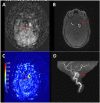Clinical applications of arterial spin labeling of the intracranial compartment in vascular anomalies-A case-based review
- PMID: 36172883
- PMCID: PMC10649537
- DOI: 10.1177/19714009221130490
Clinical applications of arterial spin labeling of the intracranial compartment in vascular anomalies-A case-based review
Abstract
Arterial spin labeling (ASL) is a magnetic resonance perfusion technique that allows for quantification of cerebral blood flow (CBF) without the use of contrast or radiation. Several applications of ASL have been described in diagnosis of strokes and stroke mimics, intracranial tumors, and other conditions. Various vascular anomalies exhibit specific CBF patterns that correlate with different signal intensities on ASL. In this case-based review, we demonstrate the utility of ASL in diagnosis and surveillance of vascular anomalies in the intracranial compartment.
Keywords: Arterial spin labeling; CEA; arteriovenous malformations; cerebral blood flow; neuroimaging; vascular anomalies.
Conflict of interest statement
Declaration of conflicting interestsThe author(s) declared no potential conflicts of interest with respect to the research, authorship, and/or publication of this article.
Figures













Similar articles
-
Arterial spin labeling clinical applications for brain tumors and tumor treatment complications: A comprehensive case-based review.Neuroradiol J. 2023 Apr;36(2):129-141. doi: 10.1177/19714009221114444. Epub 2022 Jul 10. Neuroradiol J. 2023. PMID: 35815750 Free PMC article. Review.
-
Arterial Spin Labeling for Pediatric Central Nervous System Diseases: Techniques and Clinical Applications.Magn Reson Med Sci. 2023 Jan 1;22(1):27-43. doi: 10.2463/mrms.rev.2021-0118. Epub 2022 Mar 23. Magn Reson Med Sci. 2023. PMID: 35321984 Free PMC article.
-
Arterial spin labeling magnetic resonance imaging: toward noninvasive diagnosis and follow-up of pediatric brain arteriovenous malformations.J Neurosurg Pediatr. 2015 Apr;15(4):451-8. doi: 10.3171/2014.9.PEDS14194. Epub 2015 Jan 30. J Neurosurg Pediatr. 2015. PMID: 25634818
-
Arterial Spin Labeling technique and clinical applications of the intracranial compartment in stroke and stroke mimics - A case-based review.Neuroradiol J. 2022 Aug;35(4):437-453. doi: 10.1177/19714009221098806. Epub 2022 May 30. Neuroradiol J. 2022. PMID: 35635512 Free PMC article. Review.
-
Mapping of cerebral perfusion territories using territorial arterial spin labeling: techniques and clinical application.NMR Biomed. 2013 Aug;26(8):901-12. doi: 10.1002/nbm.2836. Epub 2012 Jul 15. NMR Biomed. 2013. PMID: 22807022 Review.
References
MeSH terms
Substances
LinkOut - more resources
Full Text Sources
Medical

